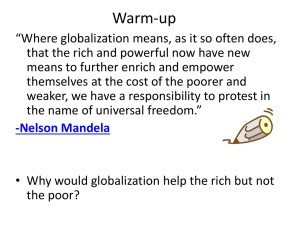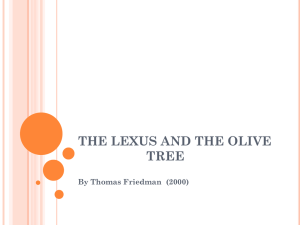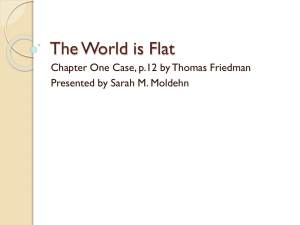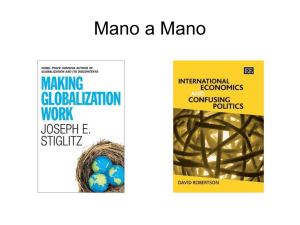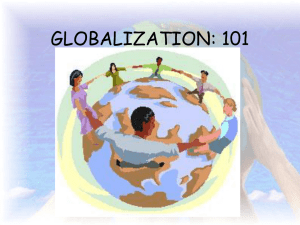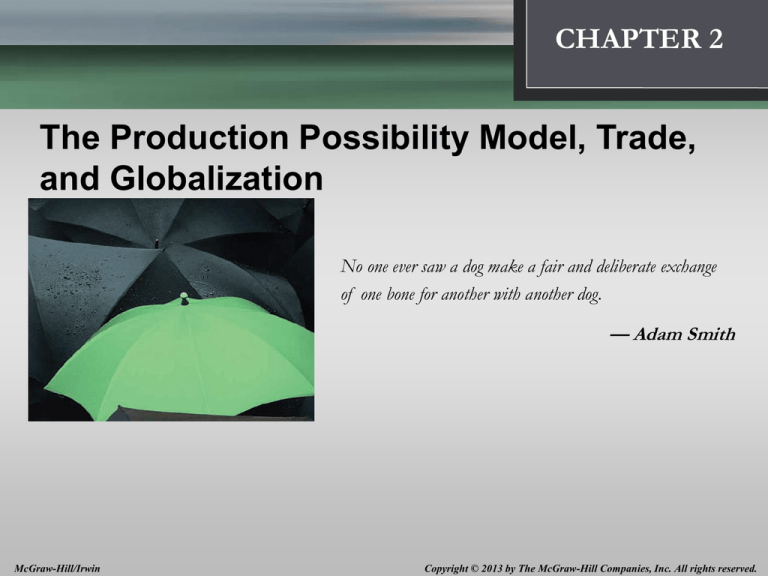
Introduction:
Thinking Like an Economist
CHAPTER 2
1
The Production Possibility Model, Trade,
and Globalization
No one ever saw a dog make a fair and deliberate exchange
of one bone for another with another dog.
— Adam Smith
McGraw-Hill/Irwin
Copyright © 2013 by The McGraw-Hill Companies, Inc. All rights reserved.
12
The Production Possibility Model,
Trade, and Globalization
The Production Possibilities Model
The production possibilities model can be presented
both in a table and in a graph
A production possibility table is a table that lists the
trade-offs between two choices
• An output is a result of an activity
• An input is what you put in a production
process to achieve an output
2-2
12
The Production Possibility Model,
Trade, and Globalization
Application: A Production Possibilities Table
History
Economics
Hrs of Study
Grade
Hrs of Study
Grade
20
98%
0
40%
18
94%
2
46%
10
78%
10
70%
4
66%
16
88%
0
58%
20
100%
What is the
output?
What is the
input?
2-3
12
The Production Possibility Model,
Trade, and Globalization
The Production Possibilities Model
A production possibility curve (PPC) is a curve
measuring the maximum combination of outputs that
can be obtained from a given number of inputs
• It gives you a visual picture of the tradeoff
embodied in a decision
• A PPC is created from a production possibility
table by mapping the table in a two-dimensional
graph
2-4
12
The Production Possibility Model,
Trade, and Globalization
Application: A Production Possibilities Curve
Econ Grade
100
A PPC demonstrates:
16 hrs for Econ and
4 hrs for History
88
10 hrs for each
History and Econ
70
PPC
40
58
66
78
• There is a limit to what you
can achieve, given existing
institutions, resources, and
technology
• Every choice you make has
an opportunity cost
100 History grade
2-5
12
The Production Possibility Model,
Trade, and Globalization
Increasing Opportunity Costs of the Trade-off
The principle of increasing marginal opportunity
cost tells us that opportunity costs increase the
more you concentrate on the activity
Butter
A
• Slope is flat at A
• This means there is a low opportunity
cost to produce more guns
B
• Slope is steep at B
• This means there is a high
opportunity cost to produce more guns
Guns
2-6
12
The Production Possibility Model,
Trade, and Globalization
Comparative Advantage
The reason we must give up more and more butter
as we produce more guns is that some resources
are relatively better suited to producing guns, while
others are relatively better suited to producing
butter.
A resource has a comparative advantage if it is
better suited to the production of one good than to
the production of another good
2-7
12
The Production Possibility Model,
Trade, and Globalization
Efficiency
Productive efficiency is achieving as
much output as possible from a given
amount of inputs or resources
Butter
A
•
• Points of efficiency
•D
•C
• Unattainable with given
amounts of inputs
• Point of inefficiency
•B
Guns
2-8
12
The Production Possibility Model,
Trade, and Globalization
Efficiency and Technological Change
Neutral technological increase
or an increase in resources
A
Biased
technological increase
A
B
B
2-9
12
The Production Possibility Model,
Trade, and Globalization
Trade and Comparative Advantage
The PPC is bowed outward because individuals
specialize in the production of goods for which they
have a comparative advantage
For a society to produce on its PPC, individuals must
produce those goods for which they have a comparative
advantage and trade for other goods
According to Adam Smith, humankind’s proclivity to
trade leads to individuals using their comparative
advantage
2-10
12
The Production Possibility Model,
Trade, and Globalization
Markets, Specialization, and Growth
• Growth in per capita income during the past 2000 years
$6,000
Income
$5,000
$4,000
$3,000
$2,000
$1,000
0
500
1000
1500
2020
Year
• What caused this growth?
2-11
12
The Production Possibility Model,
Trade, and Globalization
The Benefits from Trade
• When people freely enter into trade, both parties can be
expected to benefit from trade
Textiles (yds)
Without trade, each
country can only consume
those combinations of
goods along their PPCs
5,000
4,000
Pakistan
3,000
2,000
Belgium
1,000
1
2
3
4
5
Chocolate (tons)
2-12
12
The Production Possibility Model,
Trade, and Globalization
The Benefits from Trade
If each country specializes according to
comparative advantage and trades,
they can consume beyond
their “no-trade” PPCs
Textiles (yds)
5,000
4,000
Pakistan
3,000
•
2,000
Consumption
with trade
Belgium
Why should Pakistan
specialize in textiles
and Belgium specialize
in chocolates?
1,000
1
2
3
4
5
Chocolate (tons)
2-13
12
The Production Possibility Model,
Trade, and Globalization
Globalization and the Law of One Price
Globalization
Globalization is the increasing integration of
economies, cultures, and institutions across the world
A positive effect of globalization is that it provides
larger markets than the domestic economy
The global economy increases the number of
competitors and this increased competition can be a
negative effect of globalization
2-14
12
The Production Possibility Model,
Trade, and Globalization
Globalization and the Law of One Price
Exchange Rates and Comparative Advantage
The U.S. comparative advantage in innovation results
in higher wages in the U.S.
As industries mature, they move to lower wage countries
In order to regain our comparative advantage, the U.S.
exchange rate will decline and foreign wages will
increase to make U.S. exports cheaper and imports to
the U.S. more expensive
2-15
12
The Production Possibility Model,
Trade, and Globalization
Globalization and the Law of One Price
The Law of One Price
The law of one price states that wages of workers in
one country will not differ significantly from the wages of
(equal) workers in another institutionally similar country
If the U.S. loses its comparative advantage based on
technology and institutional structure, U.S. wages will
decrease relative to wages in many other countries
The reality is that the citizens in the U.S. have
been living better than they could have
otherwise because of globalization
2-16




